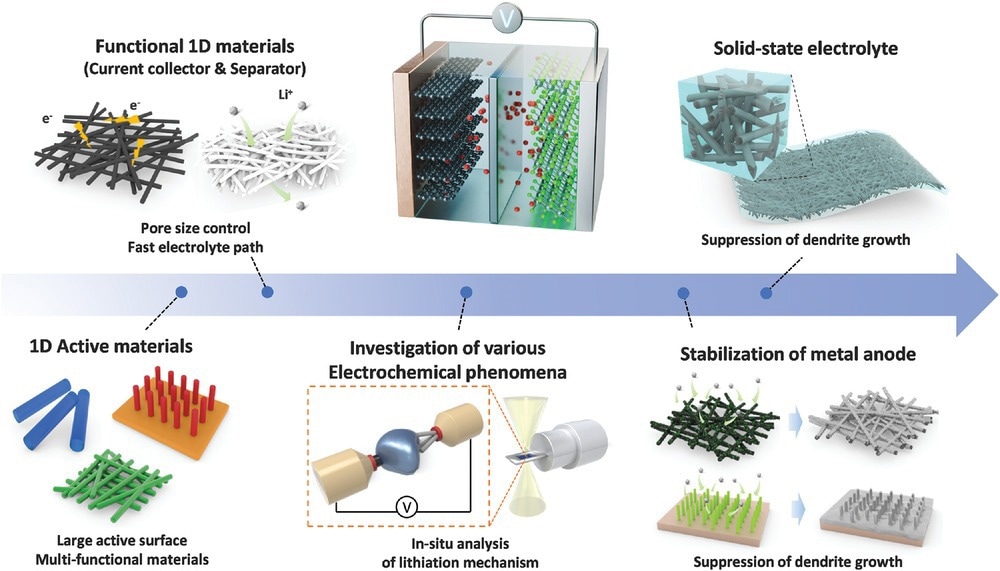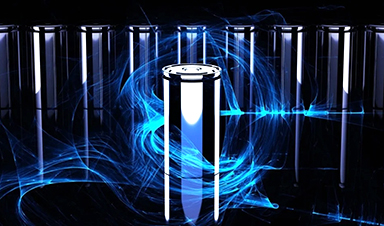One-dimensional (1D) nanostructures exhibit distinct properties that vary from those of bulk materials. They provide significant benefits in designing next-generation batteries due to facile electronic and ionic transport and strong tolerance to stress changes. Thus, contributing to the high performance of energy storage systems.
A review article published in Advanced Functional Materials systematically reviewed the latest research on rechargeable battery-based 1D nanostructures. This review highlighted a few important 1D nanostructuring methods and summarized in situ 1D nanostructure-based structural characterizations that facilitate atomic-scale monitoring of the structural evolution dynamics and reaction kinetics of electrode materials.
The stabilization of metal anodes and 1D nanostructuring in solid-state electrolytes have also been highlighted because they are not only vital for prevailing battery research trends but are also rarely covered in earlier studies.
1D Nanostructures in Batteries
Low-dimensional nanomaterials have unique properties that are not observed in macroscale materials and have applications in rechargeable batteries. Electrode materials with 1D nanostructures facilitate fast ion or electron transport, along with large contact areas between the electrode and electrolyte.
Incorporating 1D nanostructures with hierarchical, interfacial, or tubular porous geometries further accelerates electrochemical reactions by providing several active sites, short ion diffusion lengths, and strain relaxation.
The high aspect ratio of 1D nanostructures enables self-integration, which promotes the development of three-dimensional (3D) functional structures for additional battery components. However, such self-integration is unachievable through zero-dimensional (0D) or two-dimensional (2D) nanostructures owing to their low aspect ratio.
1D nanostructures stabilized metal anodes in rechargeable batteries by rendering lithiophilic 3D interlinked nanofiber-based scaffolds, which facilitate uniform metal deposition, enhance stability during stripping and metal plating, and provide adequate channels for ion transportation.
Additionally, 1D nanostructures offer novel experimental techniques and tools for the practical determination of the physicochemical characteristics of electrode materials, providing guidelines for developing high-performance batteries.

Schematic illustration on the employment of 1D nanostructures for multifunctional applications, ranging from active materials to solid-state electrolyte. © Cheong, J. Y., Cho, S.H., Lee, J., Jung, J.W., Kim, C., Kim, I.D. (2022).
Synthetic Methodologies Towards 1D Nanostructures and Their Limitations
Among the methodologies for synthesizing 1D nanostructures, solvothermal and hydrothermal synthetic strategies face several challenges, including structural predictability and control, which remain elusive in compositionally complex systems obtained via these synthetic routes. Hence, it is challenging to synthesize amorphous structures using solvothermal and hydrothermal methods.
Moreover, the formation and evolution mechanisms of various inorganic semiconducting nanostructures have been limited to hypothetical interpretations. Thus, integrating in situ transmission electron microscopy (TEM) or X-ray diffraction (XRD) into an autoclave enables the observation of reaction dynamics during crystal formation.
Chemical vapor deposition (CVD) is more favorable than the solvothermal or hydrothermal synthesis of 1D nanostructures because it allows precise or controlled synthesis. Moreover, their low production efficiency can be fixed by increasing the heating zones of the device to produce sufficient material. Although most CVD processes occur at high temperatures, synthesizing 1D nanostructures via plasma-enhanced CVD enables the process at a lower temperature.
On the other hand, the key advantages of the electrodeposition approach are low-temperature synthesis and applicability to diverse metal substrates. Nevertheless, this method is limited by the difficulty in uniformly controlling the morphology. In addition, it is challenging to employ an insulating substrate for electrodeposition using a template or a template-free method.
Although the sol-gel process is efficient, it requires a high-quality gel precursor and additional post-reaction steps to remove by-products. Electrospinning selectively facilitates the production of continuous 1D nanofibers. However, the insolubility of polymer precursors restricts their adaptability.
Alternatively, 3D printing and lithography techniques are the latest methods for preparing highly porous micro-sized lattice structures. However, these methods are limited by a lack of reliable processes for obtaining sufficient yields, a lack of suitable materials, and multistep processes in lithography techniques. Thus, by overcoming these limitations, 3D nano-printing and lithography techniques can achieve substantial development in terms of utilization and productivity in the design of energy devices.
Scope of 1D Nanostructures in Batteries
Novel battery systems such as spin- and quantum-phase batteries can be developed using 1D nanostructures. While conventional batteries provide a sustained voltage bias that can power electronic circuits by storing chemical energy, a phase-coherence-based quantum phase battery offers a quantum circuit wave function with persistent phase bias.
Owing to the unique characteristics of quantum mechanics, researchers have anticipated that batteries in the quantum phase would experience faster charging. Using 1D nanostructures has also proven the viability of rechargeable spin batteries. By applying a strong magnetic field to nanomagnets in a magnetic tunnel junction, spin batteries may store energy in magnets rather than through chemical processes.
Thus, 1D nanostructures provide enormous potential for developing new batteries and serve as a foundation for studying electrochemical dynamics using in situ or operando characterization techniques.
Conclusion
In summary, 1D nanostructures have substantially contributed to advances in battery science. The short pathways of ion or electron transport, large surface areas, and the ability for effective strain relaxation of 1D nanostructures offer excellent electrochemical performances that are not found in bulk materials.
Furthermore, constructing a nanoscale probe with a single 1D nanostructure helps investigate the electrochemical dynamics and fundamental mechanism with high resolution. This will contribute to the development of future batteries.
In addition to electrochemical analysis, integrating artificial intelligence (AI) technology is expected to contribute to significant advancements in 1D nanostructuring for real-world battery applications.
News
Platelet-inspired nanoparticles could improve treatment of inflammatory diseases
Scientists have developed platelet-inspired nanoparticles that deliver anti-inflammatory drugs directly to brain-computer interface implants, doubling their effectiveness. Scientists have found a way to improve the performance of brain-computer interface (BCI) electrodes by delivering anti-inflammatory drugs directly [...]
After 150 years, a new chapter in cancer therapy is finally beginning
For decades, researchers have been looking for ways to destroy cancer cells in a targeted manner without further weakening the body. But for many patients whose immune system is severely impaired by chemotherapy or radiation, [...]
Older chemical libraries show promise for fighting resistant strains of COVID-19 virus
SARS‑CoV‑2, the virus that causes COVID-19, continues to mutate, with some newer strains becoming less responsive to current antiviral treatments like Paxlovid. Now, University of California San Diego scientists and an international team of [...]
Lower doses of immunotherapy for skin cancer give better results, study suggests
According to a new study, lower doses of approved immunotherapy for malignant melanoma can give better results against tumors, while reducing side effects. This is reported by researchers at Karolinska Institutet in the Journal of the National [...]
Researchers highlight five pathways through which microplastics can harm the brain
Microplastics could be fueling neurodegenerative diseases like Alzheimer's and Parkinson's, with a new study highlighting five ways microplastics can trigger inflammation and damage in the brain. More than 57 million people live with dementia, [...]
Tiny Metal Nanodots Obliterate Cancer Cells While Largely Sparing Healthy Tissue
Scientists have developed tiny metal-oxide particles that push cancer cells past their stress limits while sparing healthy tissue. An international team led by RMIT University has developed tiny particles called nanodots, crafted from a metallic compound, [...]
Gold Nanoclusters Could Supercharge Quantum Computers
Researchers found that gold “super atoms” can behave like the atoms in top-tier quantum systems—only far easier to scale. These tiny clusters can be customized at the molecular level, offering a powerful, tunable foundation [...]
A single shot of HPV vaccine may be enough to fight cervical cancer, study finds
WASHINGTON -- A single HPV vaccination appears just as effective as two doses at preventing the viral infection that causes cervical cancer, researchers reported Wednesday. HPV, or human papillomavirus, is very common and spread [...]
New technique overcomes technological barrier in 3D brain imaging
Scientists at the Swiss Light Source SLS have succeeded in mapping a piece of brain tissue in 3D at unprecedented resolution using X-rays, non-destructively. The breakthrough overcomes a long-standing technological barrier that had limited [...]
Scientists Uncover Hidden Blood Pattern in Long COVID
Researchers found persistent microclot and NET structures in Long COVID blood that may explain long-lasting symptoms. Researchers examining Long COVID have identified a structural connection between circulating microclots and neutrophil extracellular traps (NETs). The [...]
This Cellular Trick Helps Cancer Spread, but Could Also Stop It
Groups of normal cbiells can sense far into their surroundings, helping explain cancer cell migration. Understanding this ability could lead to new ways to limit tumor spread. The tale of the princess and the [...]
New mRNA therapy targets drug-resistant pneumonia
Bacteria that multiply on surfaces are a major headache in health care when they gain a foothold on, for example, implants or in catheters. Researchers at Chalmers University of Technology in Sweden have found [...]
Current Heart Health Guidelines Are Failing To Catch a Deadly Genetic Killer
New research reveals that standard screening misses most people with a common inherited cholesterol disorder. A Mayo Clinic study reports that current genetic screening guidelines overlook most people who have familial hypercholesterolemia, an inherited disorder that [...]
Scientists Identify the Evolutionary “Purpose” of Consciousness
Summary: Researchers at Ruhr University Bochum explore why consciousness evolved and why different species developed it in distinct ways. By comparing humans with birds, they show that complex awareness may arise through different neural architectures yet [...]
Novel mRNA therapy curbs antibiotic-resistant infections in preclinical lung models
Researchers at the Icahn School of Medicine at Mount Sinai and collaborators have reported early success with a novel mRNA-based therapy designed to combat antibiotic-resistant bacteria. The findings, published in Nature Biotechnology, show that in [...]
New skin-permeable polymer delivers insulin without needles
A breakthrough zwitterionic polymer slips through the skin’s toughest barriers, carrying insulin deep into tissue and normalizing blood sugar, offering patients a painless alternative to daily injections. A recent study published in the journal Nature examines [...]





















